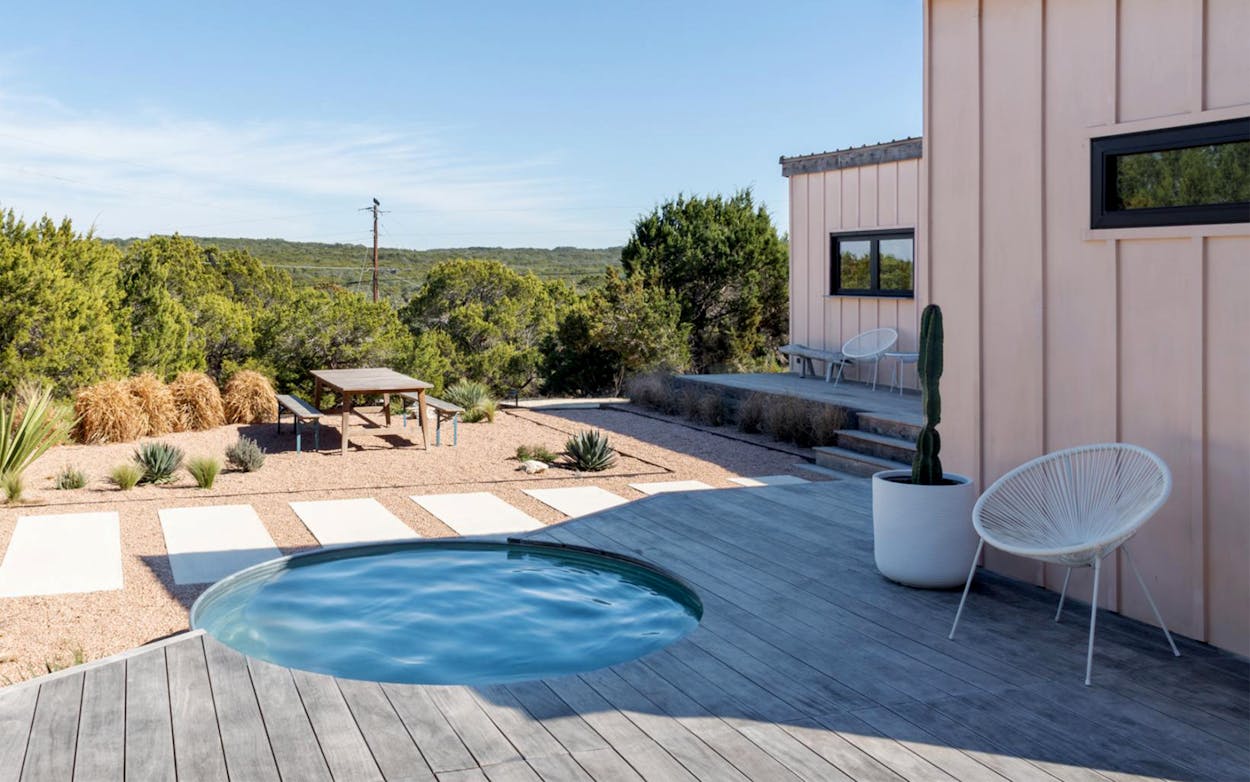Livestock have long known the magic of a stock tank, but in the last few years, the massive metal tubs have also become popular with heat-weary human Texans. Traditionally used to water and feed animals, a stock tank can double as a DIY pool for folks on a budget (and/or who can appreciate a farm-chic aesthetic). These tanks are more permanent than inflatable kiddie pools and more glamorous than the tubs cows drink from on West Texas farms. Some versions are even done up with wooden decks and side tables.
An in-ground pool typically takes months to build and comes with a price tag of about $35,000, whereas stock tanks can be ready to go within a matter of hours and only cost a few thousand. After installation, the upkeep costs are also much lower than those for a standard backyard pool. For those who are more invested in cooling off than swimming laps, a stock tank is a no-brainer.
There are step-by-step stock tank–pool tutorials online for savvy self-builders. But if you want some help in the process, you can purchase a DIY kit. The kit from Cowboy Pools comes with all of the features ready to go, from the pump to the fittings, along with detailed tutorial videos and everything you’ll need for maintenance. If you’re not handy with a drill, you can also purchase a full installation from companies such as Cowboy Pools or Stock Tank Love.
To help you make the call, the experts from Cowboy Pools in Austin and Jonestown’s Stock Tank Love offered us their advice on what to keep in mind before you head to a local feed-supply store or place an order online.
Swim on solid ground.
It’s important to set the stock tank on a smooth, level space. A single jagged rock underneath the tank can create a dent in the metal once it’s filled with water. Some people will place the tank on a concrete slab; others will level out an area in their backyard and add sand, mulch, or pea gravel. You can level the area yourself or contact a local lawn-care company.
Size up your tank.
Stock tank–pool companies typically sell eight-foot, nine-foot, and ten-foot options. A family of four can comfortably sit in an eight-foot tub. However, if you’re wanting to host, say, a pool happy hour with more than eight people, the ten-foot version is a safer bet. Also consider when you’re planning to use the pool: if you want to add a heater so the tank doubles as a jacuzzi during the winter, purchase an eight-footer, as anything larger will be difficult to heat.
Decide if you need a TikTok-worthy material.
Galvanized-metal stock tanks are the ones you’ll see scrolling on TikTok. When filled with chlorinated water, the metal usually has a lifespan of five to ten years. If you’re looking for something that won’t corrode and will last longer, choose a poly plastic option. Both usually run for about the same price.
Get some shade.
When considering where to place the pool, you’ll want to inspect your yard to find a location that gets about three hours of shade per day. Direct sunlight will leave your pool water feeling like bathwater, but too much shade will likely make the water too frigid to enjoy. You can also use a large umbrella or shade sail to control the sun exposure.
Once you purchase your stock tank, the installation process begins. Here’s some advice for building the pool and for the regular upkeep:
Be honest with yourself about maintenance.
Just how much work do you want to put into keeping this thing clean? Answer honestly, then choose the best pump for your tank: sand-filter pumps are low-maintenance, and they clean with the push of a button. Cartridge-filter pumps are typically cheaper but require more upkeep, including hosing out the cartridge about once a month.
Keep the tank clean and fresh.
Just like those other kinds of pools, you’ll need to regularly test the pH and chlorine levels with a test kit. You can use chlorine, either in tablet or liquid form, or concentrated hydrogen peroxide if you have sensitive skin. Make sure to purchase a pool cover, which will be especially useful for avoiding nasty green water during the pollen season. (For those in the Austin area who don’t want to bother with regular maintenance, Cowboy Pools offers weekly and biweekly pool service.) Over time, chemicals and body oils will build up, so it’s important to drain the pool at least once a year or as often as every three months.
- More About:
- Style & Design
- Water








